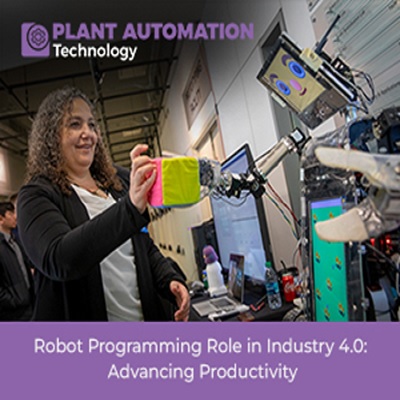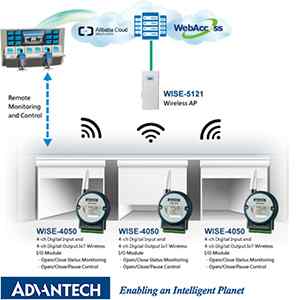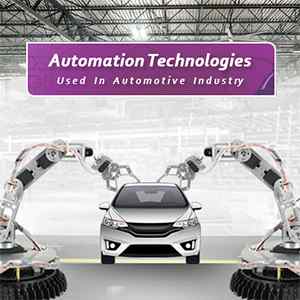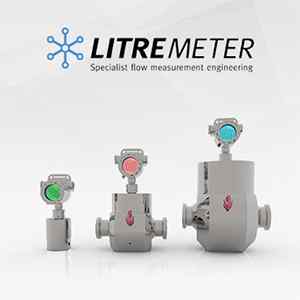Robot Programming Role in Industry 4.0: Advancing Productivity

Introduction
The era of Industry 4.0 marks a transformative phase in manufacturing, often hailed as the fourth industrial revolution. This revolution encompasses cutting-edge automation, seamless data exchange, artificial intelligence, and the interconnectedness of the Internet of Things (IoT). As a result, smart factories have emerged, demonstrating unmatched efficiency and adaptability in their production processes. Central to the success of Industry 4.0 is the art of robot programming, a fundamental element that seamlessly integrates robots into these intelligent manufacturing environments. This article delves into the paramount role played by robot programming in Industry 4.0, revolutionizing manufacturing processes, and fostering unparalleled productivity.
1. Evolution of Industrial Robotics
In the early days of industrial robotics, robots were largely confined to repetitive tasks in isolated environments. The programming methods were often rigid and required specialized skills. However, with technological advancements and the demand for more flexible and intelligent automation, robot programming has undergone significant evolution.
Early industrial robots were programmed using teach pendants or point-to-point programming, which required physically guiding the robot through the desired motions. This method was time-consuming and limited the adaptability of robots in dynamic manufacturing settings. The development of programming languages like RAPID (Robot Application Programming Interface for the ABB robot) and KRL (KUKA Robot Language) introduced more structured and versatile programming approaches. These languages allowed programmers to create complex robot motions, sequences, and interactions with peripheral equipment.
The rise of collaborative robots, or cobots, brought about safer and more intuitive programming methods, allowing humans to work alongside robots without extensive safety barriers. Cobots often feature graphical user interfaces (GUIs) that enable users to program robots through simple drag-and-drop actions, making them accessible to workers without extensive technical expertise.
2. Robot Programming in the Era of Industry 4.0
In the era of Industry 4.0, robot programming has undergone a significant transformation to align with the demands of interconnected and data-driven manufacturing systems. The seamless integration of robots into smart factories necessitated the development of programming methods that could foster communication between robots and other machines.
Robot programming in Industry 4.0 takes advantage of cutting-edge programming languages such as Python and ROS (Robot Operating System) to enable smooth interactions between robots and various devices. Through these languages, robots can exchange data and commands, collaborating not only with other robots and machines but also with human operators. This interconnectedness allows them to function as integral components of a dynamic production ecosystem.
Moreover, the rise of artificial intelligence (AI) has brought about profound changes in robot programming within the context of Industry 4.0. Machine learning algorithms empower robots to analyze extensive data sets, learn from their findings, and optimize their own performance. Consequently, robots become more efficient, capable of identifying patterns, detecting anomalies, and proactively addressing potential production issues.
By leveraging advanced programming languages and harnessing the power of AI, robot programming has become a driving force behind the enhanced adaptability and efficiency observed in Industry 4.0. As smart factories continue to evolve, the role of robot programming will remain crucial in shaping the future of manufacturing and automation.
3. Enabling Smart Manufacturing with Robot Programming
The success of Industry 4.0 hinges on the ability of robots to operate as integral parts of smart manufacturing processes. Robot programming enables this by providing the necessary intelligence and flexibility to adapt to changing production demands.
One of the key aspects of smart manufacturing is the concept of "plug-and-play" robotics, where robots can seamlessly integrate into the production line and perform various tasks without extensive reprogramming. Through sensor-based programming, robots can perceive their environment, such as detecting the presence of objects or monitoring the quality of products, and adjust their actions accordingly. This enables robots to perform tasks that were previously reserved for human workers, such as quality control and intricate assembly processes.
Additionally, swarm robotics has emerged as an exciting area of research in robot programming for Industry 4.0. In swarm robotics, multiple robots collaborate and coordinate their actions to accomplish complex tasks efficiently. This approach has the potential to revolutionize manufacturing processes by distributing tasks among multiple robots and achieving higher throughput.
4. Enhanced Productivity through Optimized Robot Programming
In Industry 4.0, the aim is to achieve higher levels of productivity and efficiency. Optimized robot programming plays a critical role in achieving this by streamlining robotic workflows and minimizing downtime.
Offline programming is a technique that significantly contributes to enhanced productivity. It allows programmers to develop and test robot programs in virtual environments without interrupting production. By creating and validating robot programs offline, manufacturers can reduce programming time and mitigate the risk of errors during the implementation phase. This approach also supports rapid reconfiguration of robot tasks, enabling quick adjustments to production lines to adapt to market demands.
Real-time data analysis and predictive maintenance are additional components that leverage optimized robot programming to boost productivity. By collecting and analyzing data from robots and other manufacturing processes, potential issues can be identified early, allowing proactive maintenance and reducing unplanned downtime.
5. Overcoming Challenges in Robot Programming for Industry 4.0
Overcoming challenges in robot programming for Industry 4.0 requires innovative solutions, despite the significant advancements in this field. Integrating robots into Industry 4.0 environments presents unique obstacles that necessitate careful consideration and strategic approaches.
One prominent challenge is ensuring seamless interoperability between different robot brands and systems. With a myriad of robot manufacturers utilizing diverse communication protocols, achieving smooth integration can be a complex task. To tackle this issue, standards like the OPC Unified Architecture (OPC UA) have been developed, providing a standardized communication framework for industrial automation systems. By adhering to these guidelines, developers can bridge the gap between various robots, promoting a cohesive and interoperable production ecosystem.
In the era of smart factories, cybersecurity emerges as a critical concern in robot programming. The increased interconnectivity of robots and other devices creates potential entry points for cyber-attacks, making safeguarding sensitive data and manufacturing processes of utmost importance. Implementing robust cybersecurity measures in robot programming is imperative to prevent unauthorized access to robots, ensure the protection of valuable information, and maintaining the integrity of smart manufacturing systems.
Addressing these challenges in robot programming not only strengthens Industry 4.0 environments but also contributes to the sustainable growth and success of modern manufacturing processes. By embracing innovative solutions and prioritizing security, industries can unlock the full potential of robot programming in the context of Industry 4.0.
6. Human-Robot Collaboration and Safety
Human-robot collaboration and safety stand as defining characteristics of Industry 4.0, emphasizing the importance of seamless interactions between humans and robots in shared workspaces. In this context, robot programming plays a pivotal role in ensuring the safety and efficiency of such collaborations.
Collaborative robots, or cobots, are equipped with sophisticated sensors and safety features that enable secure physical interaction with humans. Force-limiting technology serves as a crucial safeguard, ensuring that the robot immediately reduces its speed or halts its movements upon encountering an unexpected force. This mechanism prevents potential injuries to human co-workers and fosters a safer work environment.
Additionally, speed and proximity monitoring further enhance safety during human-robot interactions. Robots can adjust their movements in real-time based on the presence and proximity of humans, adding an additional layer of precaution to prevent accidents and collisions.
A paramount aspect of human-robot collaboration is the development of user-friendly interfaces in robot programming. Intuitive programming interfaces allow even non-experts to interact with and program robots safely. This accessibility empowers workers to efficiently instruct robots on tasks, reprogram them as needed, and collaborate seamlessly with their robotic counterparts.
By prioritizing safety and creating user-friendly interfaces, robot programming cultivates a collaborative work environment where humans and robots work hand-in-hand with confidence and efficiency. As Industry 4.0 continues to evolve, the emphasis on human-robot collaboration will remain at the forefront, bolstered by the continuous advancements in robot programming techniques.
| Also Read: Robotics Programming for Pick-and-Place Operations in Manufacturing |
7. Future Trends in Robot Programming and Industry 4.0
As the dynamic landscape of Industry 4.0 continues to unfold, robot programming remains at the forefront of technological innovation, driving a host of exciting trends and developments:
1. Empowering AI and Machine Learning: The relentless progress in AI and machine learning empowers robots with increased autonomy and decision-making capabilities. These intelligent machines continuously learn from vast datasets, enabling them to optimize their performance and adapt to changing production demands. The result is heightened productivity and flexibility within smart factories, where robots seamlessly adjust their operations to achieve optimal efficiency.
2. Immersive Virtual and Augmented Reality: The integration of virtual and augmented reality into robot programming revolutionizes the development and maintenance of robot applications. Programmers can now immerse themselves in virtual environments, visualizing and refining virtual representations of robots and manufacturing processes. This immersive approach streamlines the programming process, making it more efficient and accessible. With virtual simulations, programmers can fine-tune robotic systems with precision, leading to faster implementation and enhanced performance.
3. Exploiting the Power of 5G and Edge Computing: The convergence of 5G connectivity and edge computing significantly impacts robot programming. With reduced latency and enhanced data transfer rates, robots engage in real-time decision-making and communication. This newfound responsiveness enables robots to swiftly adapt to dynamic production environments, ensuring rapid responses and seamless coordination between machines and central systems.
As these trends converge, robot programming plays a pivotal role in shaping the future of Industry 4.0. By harnessing the potential of AI, virtual and augmented reality, and advanced connectivity, robots continue to push the boundaries of automation, productivity, and adaptability. The result is a new era of smart factories, where robots seamlessly collaborate with humans, optimize operations, and redefine manufacturing excellence.
Conclusion
Robot programming is a foundational element in the implementation of Industry 4.0 principles in manufacturing. Through advanced programming methods and human-robot collaboration, robot programming empowers smart factories to achieve unprecedented levels of productivity, efficiency, and adaptability. As technology continues to advance, robot programming will play an even more significant role in shaping the future of manufacturing and automation. By overcoming challenges and embracing emerging trends, industries can harness the full potential of robot programming to drive innovation and growth in the era of Industry 4.0.







